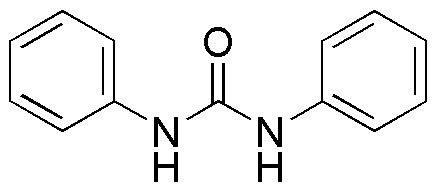1,3-Diphenylurea is widely utilized in research focused on
- Agricultural Chemistry: It serves as a key intermediate in the synthesis of herbicides and pesticides, helping to enhance crop yields and protect plants from pests.
- Pharmaceutical Development: This compound is used in the formulation of various drugs, particularly in the development of anti-cancer agents, due to its ability to inhibit certain enzymes.
- Polymer Science: It acts as a curing agent in the production of polyurethane foams, which are widely used in insulation, furniture, and automotive applications.
- Analytical Chemistry: 1,3-Diphenylurea is employed as a reagent in various analytical methods, aiding in the detection and quantification of other compounds in complex mixtures.
- Material Science: This chemical is utilized in the development of advanced materials with specific thermal and mechanical properties, making it valuable in industries such as aerospace and automotive.
General Information
Properties
Safety and Regulations
Applications
1,3-Diphenylurea is widely utilized in research focused on
- Agricultural Chemistry: It serves as a key intermediate in the synthesis of herbicides and pesticides, helping to enhance crop yields and protect plants from pests.
- Pharmaceutical Development: This compound is used in the formulation of various drugs, particularly in the development of anti-cancer agents, due to its ability to inhibit certain enzymes.
- Polymer Science: It acts as a curing agent in the production of polyurethane foams, which are widely used in insulation, furniture, and automotive applications.
- Analytical Chemistry: 1,3-Diphenylurea is employed as a reagent in various analytical methods, aiding in the detection and quantification of other compounds in complex mixtures.
- Material Science: This chemical is utilized in the development of advanced materials with specific thermal and mechanical properties, making it valuable in industries such as aerospace and automotive.
Documents
Safety Data Sheets (SDS)
The SDS provides comprehensive safety information on handling, storage, and disposal of the product.
Product Specification (PS)
The PS provides a comprehensive breakdown of the product’s properties, including chemical composition, physical state, purity, and storage requirements. It also details acceptable quality ranges and the product's intended applications.
Certificates of Analysis (COA)
Search for Certificates of Analysis (COA) by entering the products Lot Number. Lot and Batch Numbers can be found on a product’s label following the words ‘Lot’ or ‘Batch’.
*Catalog Number
*Lot Number
Certificates Of Origin (COO)
This COO confirms the country where the product was manufactured, and also details the materials and components used in it and whether it is derived from natural, synthetic, or other specific sources. This certificate may be required for customs, trade, and regulatory compliance.
*Catalog Number
*Lot Number
Safety Data Sheets (SDS)
The SDS provides comprehensive safety information on handling, storage, and disposal of the product.
DownloadProduct Specification (PS)
The PS provides a comprehensive breakdown of the product’s properties, including chemical composition, physical state, purity, and storage requirements. It also details acceptable quality ranges and the product's intended applications.
DownloadCertificates of Analysis (COA)
Search for Certificates of Analysis (COA) by entering the products Lot Number. Lot and Batch Numbers can be found on a product’s label following the words ‘Lot’ or ‘Batch’.
*Catalog Number
*Lot Number
Certificates Of Origin (COO)
This COO confirms the country where the product was manufactured, and also details the materials and components used in it and whether it is derived from natural, synthetic, or other specific sources. This certificate may be required for customs, trade, and regulatory compliance.

